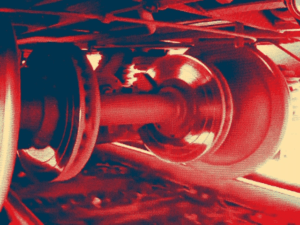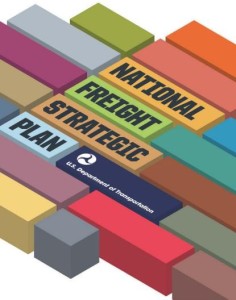Insights
Reinventing The Wheel
March 21, 2023
by Michael Sussman
Place your hand on a steel rail after a 100-car train has just passed and feel the lack of heat. Friction is low when a hard steel wheel rolls over a hard steel rail. Consequently, the wheels last for hundreds of thousands of miles and the rail lasts for decades. Low friction means that hauling heavy weight and people over rails uses 1/2 to 1/6 of the energy while producing fewer emissions than moving comparable weight over roads.

Overusing the wheel under single-vehicle cars and trucks on rubber tires over rough concrete and asphalt wastes fuel, pollutes air, and diminishes available space. Apply the simple principles of friction efficiency to the task of moving heavy weight and people over land and we take a major step toward creating a sustainable, resilient society.
Hyper-loop transit, autonomous vehicles, and flying hotel pods are all exciting possibilities. But let’s not let the spectacle of high technology blind us to the positive impact produced by the intelligent use of a steel wheel rolling on a steel track.
It’s Time to Embrace Collaboration
November 17, 2022
by Michael Sussman
”Preserving competition in the marketplace,” by itself, is an incomplete regulatory principle that must be augmented with thoughtful collaboration if we are to produce an optimal, sustainable transportation system. When we saw the need for paving muddy roads to and from the railroads in the early 20th century, we missed the opportunity to thoughtfully integrate the newly developing freight highway system with the highly developed rail system. The resulting competition in commerce and public policy triggered a disastrous long-term shrinkage of the geographic footprint of the rail network leading to a suboptimal transportation system.
Coordinating across industries, companies, agencies, and indeed political parties requires respect, collaboration, and consensus-based decision-making processes. Our governing system, however, is structured to manage competing “factions” instead. Competition in the marketplace, competition for government attention, and competitive debate, rather than thoughtful deliberation, have stifled our collective ability to address the thornier issues of our day.
Transforming Railroad Policy and Investment
November 21, 2020
by Michael Sussman
The freight rail industry has a unique opportunity to address and overcome the systemic challenges that keep our immense contributions out of the spotlight and stifle significant capital investment waiting on the sidelines.
The (Only) Path to a World-Class Transportation System is to Design it Sustainably
July 2, 2020
by Michael Sussman

Building productive transportation systems can only be accomplished by designing them sustainably. We can’t overcome unavoidable limits on clean air, stable climate, and land by just spending more money. Our new imperative must be moving freight while minimizing its impact on the environment, open space, highway capacity, and the overall costs of building and maintaining infrastructure. Given the differential between trucks and trains in the space they require for moving goods, the environmental impact of their relative fuel usage, and the efficiency of steel versus concrete and asphalt, it is critical that we shift into designing systems that optimize use of these two modes.
The market can only support this if business, government, and community cooperate. This can be accomplished by aligning around whole-system lifecycle measures and sustainable investment strategies.
Considering the pressures of increasing population on land use, transportation congestion, and the environment, three significant evolutions must occur: 1) include shorter supply chain options in planning, 2) ship as much as sensible by rail to benefit from its energy and space efficiency, and 3) proactively think and plan for reduced dependence on fossil fuels. Accomplishing these transformations must include win-win approaches that support existing transportation providers through this transition. Our existing truck, rail, water, and pipeline infrastructure is too vital to strand assets.
Has Anyone Seen The National Freight Strategic Plan?
January 27, 2019
by Michael Sussman

Submitted in 2015, the USDOT’s draft of a National Freight Strategic Plan invited public comment until April of 2016. Eighty-six comments later, the plan appears, here in early 2019, to have disappeared altogether. As a solemn marking of the third anniversary of the project’s last known activity, we’ll revisit OTNA staff’s reading and commentary of the Plan. Were we overly critical? In review, we still don’t think so. Truth be told, it was barely a plan at all — really more of a report.
Our Analysis of the Draft National Freight Strategic Plan – 2016
The National Freight Strategic Plan (NFSP) aims to serve as an outline of key issues, but its lack of depth and overall passive orientation will not lead to meaningful progress. Increasing pressures from population growth and environmental degradation compel us to think more systemically and powerfully in advancing transportation’s vital role.
For issues as critical as freight transportation, we need to integrate well-meaning government efforts with intelligent private-sector business perspectives to create not just goals and visions, but action plans and commitments. As a matter of fact, if one were to consider a plan as a living document that includes specific measures, baselines, targets, accountabilities, commitments, and action steps, the National Freight Strategic Plan does not qualify as a “Plan.”
What we have come to accept as a “Plan”, including the NFSP, is more of a report on the past, plus trends and projections, and not a plan. In doing so, we abdicate responsibility for transportation system development to the commercial marketplace that is perfectly capable of creating individual projects, but not efficient systems. The entire NFSP relates to the future of goods movement as a pre-determined fate for which citizens must simply pay the economic, environmental, and social costs that the marketplace doesn’t include, because after all, everyone benefits.
This is not a strategy for national power and it is certainly not an approach that will deliver the urgent 21st-century policy goal of economic activity that supports sustainable growth and a higher quality of community life. OnTrackNorthAmerica is providing leadership on the three key developments that are critical to enhancing the NFSP’s contribution to achieving that goal. The first is to identify the full life-cycle costs and benefits of transportation investments at the individual project and systems’ level via OnTrackNorthAmerica’s Lifecycle Project. The second is to transform transportation reports and projections into Transportation Action Plans. The third is to implement a new innovative method for collective multi-stakeholder thinking, planning, and action, called IntelliConference.
So let’s dive into the NFSP to further illuminate the specific elements which need to be augmented or added.
Decreasing Transportation Impacts on Land Use and Environment in California
November 17, 2015
by Michael Sussman
In July, California Governor Jerry Brown signed Executive Order B-32-15 directing numerous state agencies to collaborate on and develop an “integrated action plan” by July 2016 that establishes clear targets to improve freight efficiency, transition to zero-emission technologies, and increase the competitiveness of California’s freight system. Caltrans and other state agencies have already solicited comments and are now fully engaged in the development of the action plan. OnTrackNorthAmerica’s intention is that the action plan implement strategies that better deploy freight rail’s economic and environmental benefits.
OnTrackNorthAmerica (OTNA) has been working throughout 2015 to contribute its expertise in freight transportation land use planning to the state’s progress. In light of the significant projected increases in the state’s freight traffic over the next 25 years, California must focus on the optimal integration of freight transportation and land use. Lower emission truck and locomotive engines alone will not be enough. Conserving highway capacity and road maintenance expenses requires an optimal modal balance between truck and rail modes.
Revitalizing Direct Rail Service
December 10, 2014
by Michael Sussman
As Featured in Railway Age, December 2014, Page 44

Written by Michael Sussman, OnTrackNorthAmerica President and Founder
North America has yet to achieve the full extent of railroads’ potential contribution to the economy, environment, and land use. In spite of the good work of railroad developers, investors and staff, as well as significant public sector support, railroads remain underutilized for moving goods and people.
Our freight rail system is already so robust that it is easy to miss the possibility of a continental surge in capacity and reach. But railroads are energy-, capital-, and space-efficient, and these benefits are key to our future. It is time to get working on the rail system that a growing, modern society ultimately needs to be successful and sustainable.
An Open Letter to Warren Buffett
September 7, 2010
by Michael Sussman

Mr. Buffett, congratulations on your purchase of the BNSF Railway. It is a welcome investment in North America’s transportation system. It also provides a timely opening to address a systemic, long-standing problem—the incongruence between the inherent value of railroads to any well-functioning modern society and the shortfall in our investment of capital, energy, and land for rail freight and passenger transportation. Only by understanding this shortcoming and seizing the opportunity to transform its causes can we bring North America out of its economic malaise and environmental jeopardy.
If we act wisely, your acquisition will become a watershed moment. However, to make the most of it, decision-making must evolve beyond moving money simply to where the investor receives the highest return on investment, and adopting a new principle that puts capital into industries and regions in a way that maximizes the benefit of those resources to those systems. From that shared benefit, investors receive their return.
